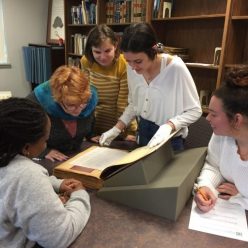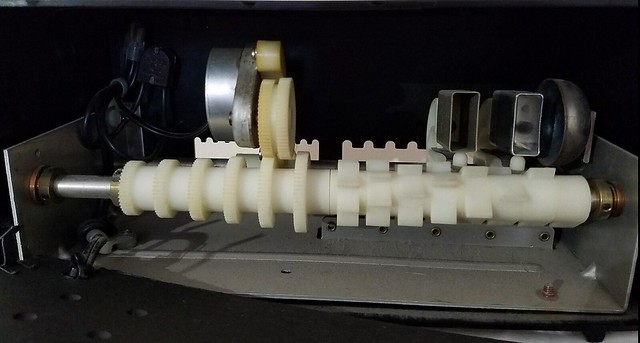by Maddie Dietrich, Music Special Collections and Research Specialist
F. Ludwig Diehn, composer, benefactor, and the man whose name is born by ODU’s Diehn School of Music, donated his personal collection of letters, scores and artifacts to ODU Special Collections and University Archives in the late 1990s. Among the items contained in the collection is a remarkable piece of apparatus known as the Billotti Trinome. It is a metronome, but it’s much more.
A simple metronome produces a click sound at regular intervals at a rate set by the user who can then self-monitor their own sense of pulse against that of the machine. The rate of speed the clicks occur is measured in beats per minute, so a metronome can be set to, say, 72 bpm, or 120 bpm, and so on. Nowadays metronomes, like clocks, are partially or fully electronic, often relying on quartz movement for establishing regularity, but older metronomes were mechanical and operated via a simple clockwork mechanism and, like mechanical clocks, were driven by a rewindable mainspring. Later metronomes would feature a small electric motor to drive the mechanism. A slightly more complex version of the mechanical metronome included a small internal bell which could be set to ring once every two, three or four clicks as desired, on the downbeat of each grouping of beats. The Billotti Trinome took this concept a step further by adding a second, independent click pitched slightly lower than the first. Combined with the bell sound the Trinome is capable of playing three separate beats simultaneously at one tempo, effectively producing what musicians call polyrhythms.
Patented by Paul Billotti in the early 1960s, a product review appearing in a 1963 issue of Music Educators Journal offers the following description. “THE BILLOTTI TRINOME, a new device billed as “the rhythm metronome,” produces beats with three different sounds—a bell, a tick, and a tock—each sound beating a different rate of speed and combining in various ways to form rhythmical patterns which can be varied by adjusting the rate of speed of each beat sound to the desired proportion relative to the speed rate of the other two beat sounds.” As a composer of 20th century music Diehn undoubtedly found the device useful when conceiving of multiple complex melodies and rhythms played against one another.
Of course the advent of electronic and computer-based metronomes and drum machines rendered a device like the Billotti Trinome obsolete, though surviving specimens occasionally surface on sites like eBay and Reverb.com and when they do they command a hefty price tag. The machine even has a cult following, so much so that the company Grover Pro Percussion commissioned a work for solo percussion which calls for the Trinome along with a set of woodblocks, bell, and triangles. A performance of the work, entitled A Stillness that Better Suits this Machine by Casey Cangelosi (2013), can be seen here: https://www.youtube.com/watch?v=XY-b188mihM (above). The video offers a fine view of the Trinome’s internal workings. A more basic demonstration of the Trinome may be viewed here: https://www.youtube.com/watch?v=Y1XnnzCX5XA.
And the beat goes on.



There is no Wikipedia entry about a trinome. One belongs there.
(I played with one for about a half hour or so in the late 60’s – early 70’s).
Note: I copied and pasted your text as a draft article in Wikipedia. It will not get published – I immediately called out that it is not my work, and included the link to your article.
The idea is to get somebody from Wikipedia to contact you, or if you choose to get in contact with them, there is an awareness.
Also, if you have the information, would love to know how many were manufactured, sold, where the factory was, and how well it did at the time.
And yes, there is a decent chance I’ll pick up one of these things from eBay or Reverb or something (and yes I’m a software engineer and musician so I am very aware of how dated this is in almost 2021 – but still, this was an achievement in music training at the time. It made an impression on me that stuck for all these decades)
Never mind – not creating the draft in Wikipedia. But still suggest one be created.